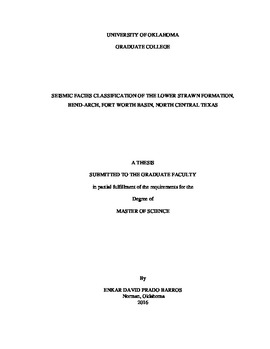| dc.description.abstract | The Bend Arch- Fort Worth Basin is a tectonically active area along north-central Texas that exhibits a complex sediment distribution. While Pennsylvanian plays have been one of the main exploratory targets, the depositional history and 3D seismic expression of the Desmoinesian Lower Strawn Formation described by Van-wagoner (1975), Gun (1979) and Pranter (1989) as a turbidite / submarine fan complex is only partially documented. In this thesis, a post-stack 3D seismic volume was conditioned to structural oriented filtering and time-frequency domain-based spectral balancing from which a set of attributes were extracted, including P-impedance, and other elastic attributes that were computed once S-impedance was predicted. Appropriate attributes were then used for unsupervised facies classification with the aim of geometrically differentiating sand bodies and architectural elements present along the Lower Strawn. After data conditioning, a suite of candidate attributes was computed. The next “exploratory data analysis” step involved comparing candidate attributes to areas where well control showed the desired sand to be present or absent. Analysis showed that several of the eight texture attributes that measure the lateral homogeneity, entropy, and other properties of the reflector exhibited value. To simplify the classification, these eight measures were reduced into one represented by the first principal component. The resulting five attributes used in classification were P-impedance, precondition seismic amplitude, peak spectral frequency (from the time-frequency analysis), the first principal component of the eight texture attributes, and the relative stratal location. The same analyses were performed to simplify ten elastic attributes. Five different classification techniques (supervised and unsupervised) were evaluated with the goal of comparing a diverse set of results: K-means clustering analysis, Self-organizing Maps (SOM), Principal Component Analysis (PCA) Generative Topographic Maps (GTM), and Principal Support Vector Machines (PSVM). The results show that some classification techniques can highlight architectural elements better than others. Although K-means and GTM were able to highlight possible channels, SOM, and PSVM, were able to discriminate more subtle facies changes along a specific area (sinuous sand bars-, fans, and possible crevasse splays features). It was the PSVM supervised classification through its binary discrimination (sandstone vs mudstone), combined with key attributes that showed strong correspondence with the evolution of geomorphological features (architectural elements), which led the interpretation of the multiple sediment source areas that compose the target sandstones of the Lower Strawn Formation. | en_US |
